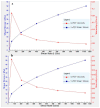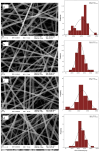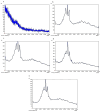Fabrication and Characterization of Buforin I-Loaded Electrospun Chitosan/Polyethylene Oxide Nanofibrous Membranes with Antimicrobial Activity for Food Packing Applications
- PMID: 40006211
- PMCID: PMC11859488
- DOI: 10.3390/polym17040549
Fabrication and Characterization of Buforin I-Loaded Electrospun Chitosan/Polyethylene Oxide Nanofibrous Membranes with Antimicrobial Activity for Food Packing Applications
Abstract
The rising resistance of bacteria to antibiotics has driven the search for new antimicrobial agents. This study focused on encapsulating Buforin I, an antimicrobial peptide, in chitosan/polyethylene oxide (CS-PEO) nanofibers. Buforin I was loaded at a minimum bactericidal concentration (MBC), 10× MBC, and 20× MBC, with assessments on morphology, thermal properties, chemical bonds, crystalline structure, mechanical strength, antimicrobial activity, and cell toxicity. Techniques like differential scanning calorimetry and Fourier-transform infrared spectroscopy confirmed the effective loading of Buforin I in the nanofibers. Scanning electron microscopy showed that Buforin incorporation increased nanofiber diameters. The tensile strength peaked at 20× MBC. Microbial tests indicated that the inhibition zone for nanofibers at 20× MBC surpassed that of commercial antibiotics. Beef coated with CS-PEO nanofibers containing Buforin I demonstrated reduced pH and water activity, alongside lower weight loss during storage. Texture and color analyses revealed that the Buforin I nanofibers helped maintain beef hardness and slowed color degradation compared to control samples. Moreover, thiobarbituric acid levels and total microbial counts in the coated beef were significantly lower than controls (below 3 log CFU/g after 9 days at 4 °C). Thus, these nanofibers may serve as effective antimicrobial packaging agents to delay food spoilage.
Keywords: Buforin I; antimicrobial membrane; antimicrobial peptide; chitosan; electrospinning; shelf life extending.
Conflict of interest statement
The authors declare no conflicts of interest.
Figures







Similar articles
-
Antimicrobial electrospun membranes of chitosan/poly(ethylene oxide) incorporating poly(hexamethylene biguanide) hydrochloride.Carbohydr Polym. 2013 Apr 15;94(1):364-71. doi: 10.1016/j.carbpol.2013.01.059. Epub 2013 Jan 28. Carbohydr Polym. 2013. PMID: 23544550
-
Synthesis, characterization, and antimicrobial properties of novel double layer nanocomposite electrospun fibers for wound dressing applications.Int J Nanomedicine. 2017 Mar 21;12:2205-2213. doi: 10.2147/IJN.S123417. eCollection 2017. Int J Nanomedicine. 2017. PMID: 28356737 Free PMC article.
-
Controlled release of cefazolin sodium antibiotic drug from electrospun chitosan-polyethylene oxide nanofibrous Mats.Mater Sci Eng C Mater Biol Appl. 2017 Feb 1;71:641-652. doi: 10.1016/j.msec.2016.10.048. Epub 2016 Oct 26. Mater Sci Eng C Mater Biol Appl. 2017. PMID: 27987755
-
Development and Characterization of Antimicrobial Chitosan/Polyethylene Oxide/Bacterial Cellulose Nanofibers.Polymers (Basel). 2025 Mar 5;17(5):693. doi: 10.3390/polym17050693. Polymers (Basel). 2025. PMID: 40076185 Free PMC article.
-
New perspectives on electrospun nanofiber applications in smart and active food packaging materials.Crit Rev Food Sci Nutr. 2024;64(9):2601-2617. doi: 10.1080/10408398.2022.2124506. Epub 2022 Sep 19. Crit Rev Food Sci Nutr. 2024. PMID: 36123813 Review.
Cited by
-
Advances in Antimicrobial Peptides: Mechanisms, Design Innovations, and Biomedical Potential.Molecules. 2025 Mar 29;30(7):1529. doi: 10.3390/molecules30071529. Molecules. 2025. PMID: 40286095 Free PMC article. Review.
References
-
- Shwaiki L.N., Lynch K.M., Arendt E.K. Future of antimicrobial peptides derived from plants in food application–A focus on synthetic peptides. Trends Food Sci. Technol. 2021;112:312–324. doi: 10.1016/j.tifs.2021.04.010. - DOI
Grants and funding
LinkOut - more resources
Full Text Sources
Molecular Biology Databases

